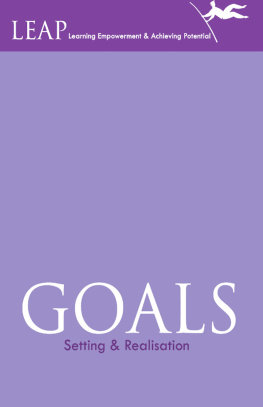Works Cited
i. New Psycho-Cybernetics Updated Edition by Maltz, Maxwell, 2002, Prentice Hall
ii. https://en.wikipedia.org/wiki/Impostor_syndrome
iii. Imes, P. R. (1978). The Imposter Phenomenon in High Achieving Women: Psychotherapy Theory, Research and Practice, 15, #3(Fall 1978)
iv. http://www.news.com.au/finance/highachievers-suffering-from-imposter-syndrome/story-e6frfm1i-1226779707766
v. Dr Helena Popovic, author of NeuroSlimming, told Australias ABC radio she teaches a similar technique for people to overcome diet cravings
vi. http://www.fastcompany.com/52717/change-or-die
vii. http://www.ornishspectrum.com/wp-content/uploads/dean-ornish-conversation.pdf
viii. W. Van Eerde, University of Amsterdam; P. Steel, University of Calgary; P. Gollwitzer, New York University, and others
ix. Steel, P. Arousal, avoidant and decisional procrastinators: Do they exist? Personality and Individual Differences (2010),
x. Dijksterhuis A (November 2004). Think different: the merits of unconscious thought in preference development and decision making. Journal of Personality and Social Psychology 87 (5): 58698
xi. Cleeremans A (2011). The Radical Plasticity Thesis: How the Brain Learns to be Conscious. Frontiers in Psychology 2: 86.
xii. http://harvardmagazine.com/2013/01/the-placebo-phenomenon
xiii. Prof T. Greenhalgh, Role of routines in collaborative work in healthcare organisations. BMJ 2008; 337
xiv. Experts bodies, experts minds: How physical and mental training shape the brain. Frontiers in Human Neuroscience. Debarnot U et al, May 2014 May 7
xv. Mental practice enhances surgical technical skills: a randomized controlled study. Arora et al, Annals of Surgery, Volume 253, Number 2, February 2011
xvi. http://www.theglobeandmail.com/life/health-and-fitness/health/surgeons-study-benefits-of-visualizing-procedures/article22681531/
xvii. Placebo Effects in Autism: Lessons from Secretin. Sandler AD, et al. Journal of Developmental & Behavioral Pediatrics: October 2000 Volume 21 Issue 5 ppg 347-350
xviii. MindBody Therapies for the Management of Pain. Clinical Journal of Pain, Astin, 20.1 (2004), pp27-32
xix. Imaging how attention modulates pain in humans using functional MRI. Brain, a Journal of Neurology Susanna J. Bantick et al, 2002 vol 125, pp310-319
xx. Goals Gone Wild: The Systematic Side Effects of Over-Prescribing Goal Setting by Lisa D. Ordez, Maurice E. Schweitzer, Adam D. Galinsky, and Max H. Bazerman. Working paper 09-083
xxi. (http://www.theinvisiblegorilla.com/videos.html)
xxii. New England Journal of Entrepreneurship, Vol. 10 [2007], No. 1, Art. 5
xxiii. Weick, K. (1984). Small wins: Redefining the scale of social problems. American Psychologist, Volume: 39, Issue: 1, Pages: 40-49
xxiv. Strategies of Setting and Implementing Goals, Oettingen, G., Gollwitzer, P. M., Social Psychological Foundations of Clinical Psychology (Eds Maddux and Tangney). Also work by Sheeran P., Brandsttter V., Martiny-Huenger T., Prestwich A., et al
xxv. Drucker, Peter F. The Practice of Management. New York: Harper & Row, 1954. Print.
xxvi. https://www.youtube.com/watch?v=Kqj_u6cL0xs run starts at 5:52
xxvii. http://www.ted.com/talks/astro_teller_the_unexpected_benefit_of_celebrating_failure
xxviii. Strategies of Setting and Implementing Goals, Oettingen, G., Gollwitzer, P. M., Social Psychological Foundations of Clinical Psychology (Eds Maddux and Tangney). Also work by Sheeran P., Brandsttter V., Martiny-Huenger T., Prestwich A., et al
Praise for the Author
This book gives a different take on goal setting from the books Ive seen so far. It brings in new ideas and examples, and covers many techniques that actually work for people setting goals. Many of these are techniques I use in skiing, and in life. Chris talks about goals, why they are important, and how to properly set them. He also writes about the importance of path, visualization, mentors, techniques for achieving and overcoming failure, the importance of responsibility, and even timing of when to reveal your goals to others.
Winning the slalom World Cup title was my goal from the beginning of the 2012/2013 race season. The World Championships title was incredible, but it wasnt the goal that I had set. It was a stepping-stone on the path to my goal. In order to win the World Cup title, I had to perform at my top level in every single race that season I was careful about putting any one race above another in importance, because that would change my focus to being oriented around individual races, rather than my goal that season. I tried to think of the World Championships as another normal race, even though it is the most prestigious event in World Cup skiing aside from the Olympics. At the end of the season I considered winning the gold at the World Championships as one of my greatest accomplishments, but because it wasnt what I had set out to do, I saw it as a bonus cherry on top of the very sweet cake that was my entire season.
My overall goal, my dream, is to be a great skier winning in all of the different events. I believe that people create their own luck. The most successful people in the world have had their fair share of suffering, obstacles, and hard work, and were able to rise above it all because they set goals and put in the effort to prepare. For me, slalom has been a part of the process of creating my own luck, or creating my own miracle.
Visualization plays a huge role in my improvement and performance. In training I use technical queues and imagine myself skiing the perfect turn around each gate. In competition, I focus on the feeling I have gotten from training when I ski that perfect turn, and that feeling drives me down the course, allowing me to free my mind without being mindless. When my mind is free, my muscles take over. All of my preparation to that point is brought to the forefront, and I just know what to do. I dream about skiing and I feel it every day. Have I had some failures? Yes, I have, but being a champion is about overcoming failures, facing adversity and then winning. Winning doesnt always mean gold. Winning is when you set your mind to a goal, and you accomplish it.
I have many goals, but I dont talk about all of them to everyone. Some might seem too lofty, arrogant, or downright crazy to other people. There are times to reveal your goals and times to keep them to yourself.
My parents have been my mentors, teaching me to be the best I can be. Winning has come as a product of always striving to be my best. I have had some great coaches and Ive watched and analyzed many awesome skiers in my career those mentors have played a huge part in my success and achievements.
As a 21 year old, its really important to me to connect with the younger kids. I like to get some time face-to-face with them to show them that Im not actually that different from them. Chris uses examples through his book to show how achievers are people just like you, and achievements like theirs are accessible to you as well.
Whatever your goal, this book will give you approaches to setting goals that you can tailor to your own beliefs, personality, and motivation and help you create your own miracle. Have fun with it!
Mikaela Shiffrin, Reigning Olympic, World Cup, and World Champion Slalom Skier
As an athlete, author, real estate investor and business owner, I have been setting goals consciously or unconsciously all my life. Because I love finding new and better ways of doing things, I was naturally intrigued by the concept of Goal Setting for People Who Cant Set Goals . I was delighted to discover so many new and interesting approaches to achieving goals and I learned a great deal. It is an entertaining read, well researched with pertinent anecdotes. Chris Christoff succeeds in demystifying the art of goal setting and offers easy to follow, proven and practical steps for achieving your hearts desire. Reading his book can change your life!











